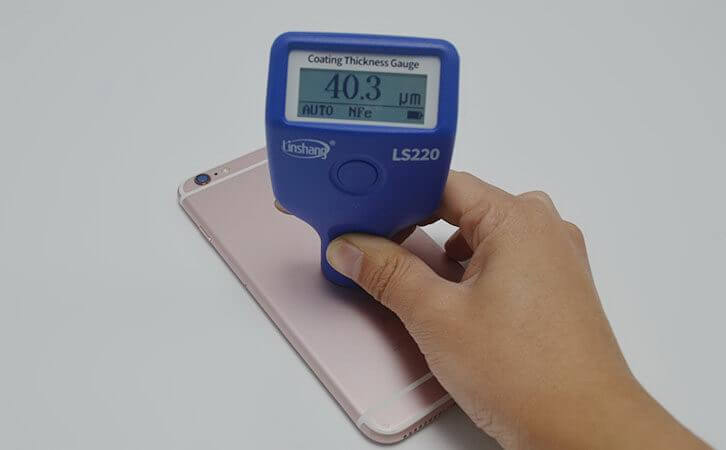How to Detect Coating Thickness and Choose Coating Thickness Gauge?
1. What are the coating thickness detection methods?
The coating thickness test method can be divided into destructive testing and non-destructive testing. Destructive testing methods mainly include timed liquid thickness measurement, dissolution method, electrolytic thickness measurement, etc. This method is generally tedious and is mainly used in laboratories. Common non-destructive testing methods include coulomb-charge method, magnetic thickness measurement method, eddy current thickness measurement method, ultrasonic thickness measurement method and radiation thickness measurement method, etc. Various non-destructive thickness measurement methods have molding equipment and portable coating thickness gauges. The portable coating thickness gauge has simple operation and cause no damage to the coating. Therefore, non-destructive thickness measurement methods have been widely used.
(1) Magnetic Thickness Measurement
Magnetic coating thickness gauge is a commonly used instrument in nondestructive measurement. It is designed based on the influence of non-magnetic plating and coating on magnetic force and magnetic induction on the magnetic substrate. Due to the different thicknesses of the non-magnetic plating and coating, the magnetic flux in the closed magnetic circuit changes accordingly, so that the magnetic resistance of the non-magnetic plating and coating on the magnetic substrate can be measured, thereby reflecting the local thickness of the measured part. This coating thickness measurement instrument can be used to measure non-magnetic plating thickness, chemical conversion coating thickness on steel substrates.
(2) Eddy current thickness measurement
Another commonly used instrument in nondestructive measurement is a high-frequency eddy current coating thickness gauge. It uses a probe coil carrying a high-frequency current to cause a high-frequency magnetic field to be generated on the plating surface or measured coating. The conductor under the probe generates eddy currents and the magnetic field generated by the sub-eddy currents in turn reacts with the probe coils, causing their impedance to change. With the coating thickness, the change in the distance between the probe coil and the base metal surface lead the change of the probe coil impedance and the measured impedance value.
The commonly used portable coating thickness gauges on the market are the application of the above two methods, which can test the thickness of various non-magnetic coating (such as paint layers and dusting layers on iron plates. , porcelain coating, chrome plating, copper plating, zinc plating) thickness on various magnetic substrates (such as steel). The eddy current coating thickness gauge can detect the thickness of all non-conductive coating thickness on non-magnetic (such as paint layer, dusting layer, porcelain coating) metal substrates (such as aluminum, copper, brass, stainless steel, etc.).
2. What is the purpose of coating thickness inspection?
Coating thickness is one of the important indicators to measure the coating quality and it plays an important role in product quality, process control and cost control. The coating thickness greatly affects the reliability and value of the product. Through the inspection of the coating thickness, in addition to assessing whether the workpiece with tolerance indicators or repair size requirements is reasonable, it can also directly or indirectly evaluate the coating's corrosion resistance, wear resistance and other properties. Therefore, it is widely used in coating quality inspection and process research.
In the production process of color-coated board, the coating thickness must be accurately measured. The purpose is to ensure that the coating reaches the specified thickness and avoid premature failure of the coating due to inappropriate thickness or excessive coating thickness. In order not to damage the coating surface structure and establish a uniform standard, it is necessary to standardize the coating thickness detection. According to relevant standards, a coating thickness gauge is applicable.
3. Precautions for using the coating thickness gauge
Coating thickness detector is also called coating thickness gauge, film thickness gauge, coating thickness meter or paint film thickness gauge, etc. It is mainly for coating thickness test on metal substrates. We need to pay attention to something when using the coating thickness gauge:
The instrument needs to strictly avoid collision, heavy dust, humidity, strong magnetic fields, oil pollution, etc.
Avoid lifting the instrument prematurely during the measurement. If you lift the instrument without hearing the prompt, an error message will be displayed and the measurement needs to be repeated.The interval between two measurements shall be not less than 2 seconds.
When measuring, the probe must be in direct contact with the tested material.
Coating thickness gauges are widely used in the industry, such as testing the thickness of metal coatings. If the thickness of the detected metal coating is not uniform, it will affect the quality and aesthetics of the product. Therefore, the choice of coating thickness gauges is very important, so how to choose?
Linshang LS220H coating thickness gauge can be used to detect the thickness of non-magnetic coatings on ferromagnetic metal substrates such as steel and the thickness of non-conductive coatings on various non-magnetic metal substrates. The measurement range is 2mm.
Only by selecting a good coating thickness gauge manufacturer, will the purchased products quality be guaranteed. Powerful manufacturers have a good service system. If the product is damaged during the use time, there is a warranty service. Linshang Technology as a coating thickness gauge manufacturer, provide 90 days of unexplained returns, one year warranty, lifetime maintenance and other services.
- High precision coating thickness gauge for used car
- Automotive paint protection films coating thickness gauge
- Plating Thickness Measuring Instrument for Detecting Anti-corrosion Coating
- Linshang LS220, LS191, LS160A– Necessary for Car Cover Inspection
- Coating Thickness Gauge for Second Hand Vehicle
- Zero Adjustment Step of Coating Thickness Gauge
